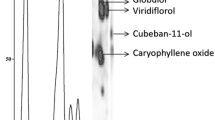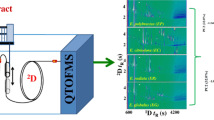Abstract
Methods such as gas chromatography coupled with mass spectrometry (GC–MS) are crucial for identification compounds of essential oils. This is a necessity when analyzing highly complex samples; all overlapped signals must be resolved and identified with high confidence. In this study, gas chromatography–mass spectrometry (GC–MS) combined with iterative resolution methods was used to characterize the essential oil components of Iranian Dracocephalum moldavica L. (D. moldavica). Due to the medicinal importance of D. moldavica, full identification of the components was performed using for the first time multivariate curve resolution-alternative least squares (MCR-ALS) as an auxiliary means to the analysis overlapping peaks. The analysis of GC–MS data revealed that 47 components exist in the D. moldavica essential oil and a total of 40 components were identified by direct similarity searches. However, with the help of MCR and different chemometric methods, the numbers of all resolved components were extended to 63 and a total of 54 components were identified by reversed matching with reference spectra. Major constituents in D. moldavica were neral (22.10%), geraniol (5.28%), E-citral (30.40%), neryl acetate (2.68%), and geranyl acetate (29.59%). The results proved that combining MCR techniques with GC–MS produces a powerful tool for the analysis of complex samples.





Similar content being viewed by others
References
Nikitina AS, Popova OI, Ushakova LS, Chumakova VV, Ivanova LI (2008) Studies of the essential oil of Dracocephalum moldavica cultivated in the stavropol region. Pharm Chem J 42:35–39
Dastmalchi K, Damien Dorman HJ, Laakso I, Hiltunen R (2007) Chemical composition and antioxidative activity of Moldavian balm (Dracocephalum moldavica L.) extracts. LWT 40:1655–1663
Zeng Q, Jin HZ, Fu JJ, Qin JJ, Hu XJ, Liu JH, Jin Hz (2010) Chemical constituents of plants from the genus Dracocephalum. Chem Biodivers 7:1911–1929
Kakasy AZ, Lemberkovics E, Simándi B, Lelik L, Héthelyi E et al (2006) Comparative study of traditional essential oil and supercritical fluid extracts of Moldavian dragonhead (Dracocephalum moldavica L.). Flavour Fragr J 21:598–603
Salisova M, Soma S, Mason TJ (1997) Comparison of conventional and ultrasonically assisted extractions of pharmaceutically active compounds from Salvia of ficinalis. Ultrason Sonochem 4:131–134
Cuevas-Glory LF, Pino JA, Santiago LS, Sauri-Duch E (2007) A review of volatile analytical methods for determining the botanical origin of honey. Food Chem 103:1032–1043
Luque de Castro MD, Priego-Capote F (2010) Soxhlet extraction: past and present panacea. J Chromatogr A 1217:2383–2389
Omar J, Olivares M, Manuel Amigo J, Etxebarria N (2014) Resolution of co-eluting compounds of Cannabis sativa in comprehensive two-dimensional gas chromatography/mass spectrometry detection with multivariate curve resolution-alternating least squares. Talanta 121:273–280
Azimi F, Fatemi MH (2016) Multivariate curve resolution-assisted GC–MS analysis of the volatile chemical constituents in Iranian Citrus aurantium L. peel. RSC Adv 6:111197–111209.10
Asadollahi-Baboli M, Mani-Varnosfaderani A (2014) Chemometrics-assisted GC–MS analysis of volatile and semi-volatile constituents of Elettaria cardamomum. Food Anal Methods 7:1745–1754
Jalali-Heravi M, Parastar H, Ebrahimi-Najafabadi H (2010) Self-modeling curve resolution techniques applied to comparative analysis of volatile components of Iranian saffron from different regions. Anal Chim Acta 662:143–154
Jalali-Heravi M, Moazeni-Pourasil R, Sereshti H (2015) Elimination of chromatographic and mass spectrometric problems in GC–MS analysis of lavender essential oil by multivariate curve resolution techniques: improving the peak purity assessment by variable size moving window-evolving factor analysis. J Chromatogr A 983–984:83–89
Maeder M, Zilian A (1988) Evolving factor analysis, a new multivariate technique in chromatography. Chemom Intell Lab Syst 3:205–213
Den W, Malinowski ER (1993) Investigation of copper (II)-Ethylenediamine tetraacetate complexation by window factor analysis of ultraviolet spectra. J Chemom 7:89–98
Liang YZ, Kvalheim OM, Keller HR, Massart DL, Kiechle P et al (1992) Heuristic evolving latent projections: resolving two-way multicomponent data. 2. detection and resolution of minor constituents. Anal Chem 64:946–953
Liang YZ, Kvalheim OM (1994) Diagnosis and resolution of multiwavelength chromatograms by rank map, orthogonal projections and sequential rank analysis. Anal Chim Acta 292:5–15
Vandeginste B, Essers R, Bosman T, Reijnen J, Kateman G (1985) Three-component curve resolution in liquid chromatography with multiwavelength diode array detection. Anal Chem 57:971–985
Izadmanesh Y, Garreta-Lara E, Ghasemi JB, Lacorte S, Tauler R (2017) Chemometric analysis of comprehensive two dimensional gas chromatography–mass spectrometry metabolomics data. J Chromatogr A 1488:113–125
Karjalainen E (1989) The spectrum reconstruction problem: use of alternating regression for unexpected spectral components in two-dimensional spectroscopies. Chemom Intell Lab Syst 7:31–38
Jalali-Heravi M, Moazeni RS, Sereshti H (2011) Analysis of Iranian rosemary essential oil: application of gas chromatography–mass spectrometry combined with chemometrics. J Chromatogr A 1218:2569–2576
Ghaheri S, Masoum S, Gholami A (2016) Resolving of challenging gas chromatography–mass spectrometry peak clusters in fragrance samples using multicomponent factorization approaches based on polygon inflation algorithm. J Chromatogr A 1429:317–328
Gong F, Liang YZ, Cui H, Chau FT, Chan BTP (2001) Determination of volatile components in peptic powder by gas chromatography–mass spectrometry and chemometric resolution. J Chromatogr A 909:237–247
Pharmacopoea Europaea (2000) Nachtrag. Bologische Wertbestim-mungen. Deutscher Apotheker Verlag Stuttgart, Govi-Verlag-pharmazeutischer Verlag GmbH Eschborn, pp 87–90
Adams RP (2007) Identification of essential oil components by gas chromatography/mass spectrometry. Allured Publishing Corporation, Carol Stream
Cook DW, Rutan SC, Stoll DR, Carr PW (2015) Two dimensional assisted liquid chromatography: a chemometric approach to improve accuracy and precision of quantitation in liquid chromatography using 2D separation, dual detectors, and multivariate curve resolution. Anal Chim Acta 859:87–95
Hugelier S, Devos O, Ruckebusch C (2015) Constraining shape smoothness in multivariate curve resolution–alternating least squares. J Chemometrics 29:448–456
Kvalheim OM, Liang YZ (1992) Heuristic evolving latent projections: resolving two-way multicomponent data. 1. Selectivity, latent-projective graph, datascope, local rank, and unique resolution. Anal Chem 64:936–946
Shen H, Liang YZ, Kvalheim OM, Manne R (2000) Determination of chemical rank of two-way data from mixtures using subspace comparisons. Chemom Intell Lab Syst 51:49–59
Maham M, Akbari H, Delazar A (2013) Chemical composition and antinociceptive effect of the essential oil of Dracocephalum moldavica L. Pharm Sci 18:187–192
Nikitina AS, Popova OI, Ushakova LS, Chumakova VV, Ivanova LI (2008) Studies of the essential oil of Dracocephalu mmoldavica cultivated in the stavropol region. Pharm Chem J 42:203–207
Eaqub Ali Md, Abdur Razzak Md, Abd Hamid SB (2014) Multiplex PCR in species authentication: probability and prospects—a review. Food Anal Methods 7:1933–1949
Chu SS, Liang Liu S, Liu QZ, Liu ZL, Du SS (2011) Composition and toxicity of Chinese Dracocephalum moldavica (Labiatae) essential oil against two grainstorage insects. J Med Plants Res 5:5262–5267
Author information
Authors and Affiliations
Corresponding author
Ethics declarations
Conflict of interest
The authors declare that they have no conflict of interest.
Ethical Approval
This article does not contain any studies with human or animal subjects.
Informed Consent
Informed consent was not applicable.
Additional information
An erratum to this article is available at http://dx.doi.org/10.1007/s10337-017-3353-8.
Electronic supplementary material
Below is the link to the electronic supplementary material.
10337_2017_3322_MOESM1_ESM.pdf
Fig. 1S (a)–(e) Resolved mass spectra of the corresponding components in peak cluster X. For brevity, the standard mass spectra are not shown and only the name of the identified compounds in the library and corresponding reverse match factors (RMF) are reported for each mass spectrum (PDF 520 kb)
Rights and permissions
About this article
Cite this article
Tajabadi, F., Khalighi-Sigaroodi, F. & Rezazadeh, S. Improving Gas Chromatography–Mass Spectrometry Analysis of Essential Oils by Multivariate Curve Resolution: Full Identification of Co-eluting Compounds of Dracocephalum moldavica L.. Chromatographia 80, 1069–1077 (2017). https://doi.org/10.1007/s10337-017-3322-2
Received:
Revised:
Accepted:
Published:
Issue Date:
DOI: https://doi.org/10.1007/s10337-017-3322-2




